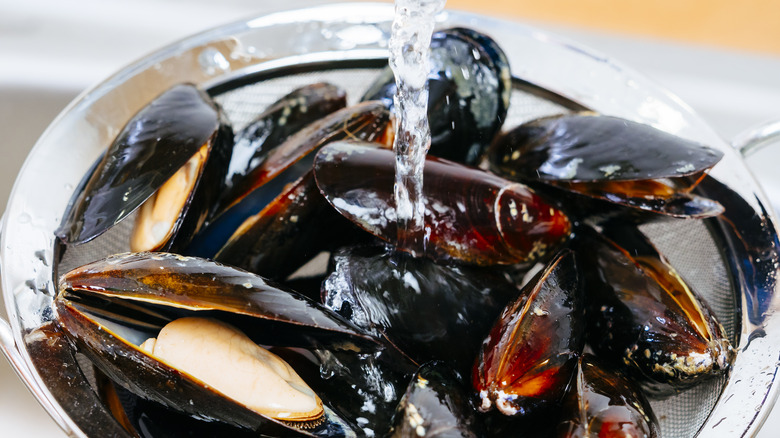How To Clean Mussels To Avoid An Unpleasantly Gritty Bite
A huge bowl of mussels soaking in rich, flavorful sauce with a side of herbaceous frites is my go-to dish at any French restaurant (despite Anthony Bourdain's mussel-ordering advice). But mussel consumption doesn't have to be restricted to restaurants – mussels are relatively affordable, sustainable, and nutritious, and though it can seem scary to cook live mollusks, preparing delicious mussels at home is quite easy (forget the canned fish route). The most confusing part, and the bit that scares off many home cooks, is cleaning them. A wonderful seafood feast can indeed be ruined by unpleasantly gritty mussels, but this fate is easily avoided with proper cleaning techniques.
One trick that will help ensure a grit-free experience is to soak the mussels in cold salt water for 10 to 20 minutes before scrubbing them. This draws any stubborn grit out. After the soak, scrub the mussels one at a time with a coarse sponge. Throw away any mussels that don't close during this process or have damaged or broken shells. Finally, remove any beards — those little stringy fibers that stick out of the shell near the hinge.
Other mussel cooking tips
It's important to note the distinction between farmed and wild mussels, as it will impact the cleaning process. Cultivated mussels are much easier to clean than wild ones. If you're cooking farmed mussels, the salt water soak might not be necessary as they are much less likely to contain grit. Another benefit of cultivated mussels is that, in contrast to some other forms of farm-raised seafood, they're quite environmentally sustainable. They can even provide environmental benefits by filtering the surrounding seawater. Flavor-wise, wild mussels may have a stronger, gamier taste, while cultivated mussels are typically more subtle and succulent. Most mussels available at grocery stores will probably be farmed. If you are cooking wild mussels, be aware that the cleaning process will likely be a bit more tedious.
Once your mussels are clean, cooking them couldn't be easier. Steaming is the simplest and most reliable mussel-cooking method. The basic idea is to sauté some herbs and veggies in oil or butter to form an aromatic base – think shallots, ginger, garlic, lemongrass, whatever flavorful deliciousness your heart desires. Then, add the mussels and a steaming liquid, bring to a boil, cover, and cook for roughly five minutes. And voila — an impressive and delectable seafood meal in no time! With the right techniques, making mussels at home is easy, tasty, and totally grit-free.

